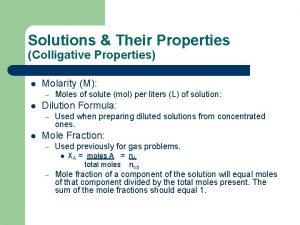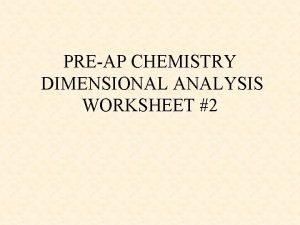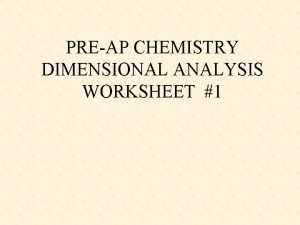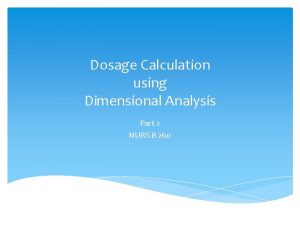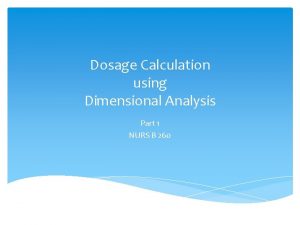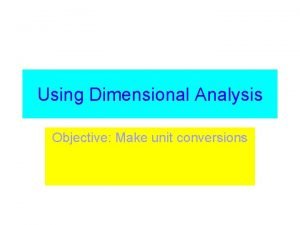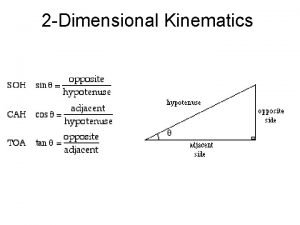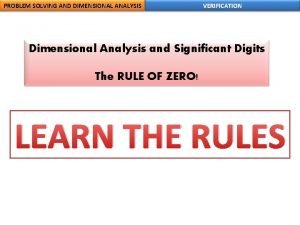Dimensional Analysis Dimensional Analysis It is a pure












- Slides: 12

Dimensional Analysis

Dimensional Analysis It is a pure mathematical technique to establish a relationship between physical quantities involved in a fluid phenomenon by considering their dimensions. In dimensional analysis, from a general understanding of fluid phenomena, we first predict the physical parameters that will influence the flow, and then we group these parameters into dimensionless combinations which enable a better understanding of the flow phenomena. Dimensional analysis is particularly helpful in experimental work because it provides a guide to those things that significantly influence the phenomena; thus it indicates the direction in which experimental work should go.

Dimensional Analysis refers to the physical nature of the quantity (Dimension) and the type of unit used to specify it. Distance has dimension L. Area has dimension L 2. Volume has dimension L 3. Time has dimension T. Speed has dimension L/T

Application of Dimensional Analysis • Development of an equation for fluid phenomenon • Conversion of one system of units to another • Reducing the number of variables required in an experimental program • Develop principles of hydraulic similitude for model study

Basic Concepts • All theoretical equations that relate physical quantities must be dimensionally homogeneous. That is, all the terms in an equation must have the same dimensions. For example Q = A. V (homogeneous) L 3 T-1 = L 3 T-1 • We do, however sometimes use no homogeneous equation, the best known example in fluid mechanics being the Manning equation. Mannings equation is an empirical equation. Generally the use of such equations is limited to specialized areas.

Methods for Dimensional Analysis • Rayleigh’s Method • Buckingham’s ∏-method

Buckingham’s ∏ method Procedure • List all physical variables and note ‘n’ and ‘m’. n = Total no. of variables m = No. of fundamental dimensions (That is, [M], [L], [T]) • Compute number of ∏-terms by (n-m) • Write the equation in functional form • Write equation in general form • Select repeating variables. Must have all of the ‘m’ fundamental dimensions and should not form a ∏ among themselves • Solve each ∏-term for the unknown exponents by dimensional homogeneity.

Buckingham’s ∏ method Example: • Let us apply Buckingham’s ∏ method to an example problem that of the drag forces FD exerted on a submerged sphere as it moves through a viscous fluid. We need to follow a series of following steps when applying Buckingham’s ∏ theorem. • Step 1: Visualize the physical problem, consider the factors that are of influence and list and count the n variables. We must first consider which physical factors influence the drag force. Certainly, the size of the sphere and the velocity of the sphere must be important. The fluid properties involved are the density ρ and the viscosity μ. Thus we can write f (FD, D, V, ρ, μ) = 0 Here we used D, the sphere diameter, to represent sphere size, and f stands for “some function”. We see that n = 5. Note that the procedure cannot work if any relevant variables are omitted. Experimentation with the procedure and experience will help determine which variables are relevant.

Buckingham’s ∏ method • Step 2: Choose a dimensional system (MLT or FLT) and list the dimensions of each variables. Find m, the number of fundamental dimensions involved in all the variables. Choosing the MLT system, the dimensions are respectively MLT-2 , LT-1 , ML-3 , ML-1 T-1 We see that M, L and T are involved in this example. So m = 3. • Step 3: Determine n-m, the number of dimensionless ∏ groups needed. In our example this is 5 – 3 = 2, so we can write Ф(∏ 1. ∏ 2) = 0 • Step 4: Form the ∏ groups by multiplying the product of the primary (repeating) variables, with unknown exponents, by each of the remaining variables, one at a time. We choose ρ, D, and V as the primary variables. Then the ∏ terms are ∏ 1 = Da Vb ρ c FD ∏ 2 = Da Vb ρc μ-1

Buckingham’s ∏ method • Step 5: To satisfy dimensional homogeneity, equate the exponents of each dimension on both sides on each pi equation and so solve for the exponents ∏ 1 = Da Vb ρc FD = (L)a (LT-1)b (ML-3)c (MLT-2) = M 0 L 0 T 0 Equate exponents: L: a +b -3 c +1 = 0 M: c +1 = 0 T: -b -2 = 0 We can solve explicitly for b = -2, c = -1, a = -2 Therefore ∏ 1 = D-2 V-2 ρ-1 FD = FD/(ρ V 2 D 2)

Buckingham’s ∏ method Finally, add viscosity to D, V, and ρ to find ∏ 2. Select any power you like for viscosity. By hindsight and custom, we select the power -1 to place it in the denominator ∏ 1 = Da Vb ρc μ-1 = (L)a (LT-1)b (ML-3)c (ML-1 T-1 )-1 = M 0 L 0 T 0 Equate exponents: L: a +b -3 c +1 = 0 M: c -1 = 0 T: -b +1 = 0 We can solve explicitly for b = 1, c = 1, a = 1 Therefore, ∏ 2 = D 1 V 1 ρ1 μ-1 = (D V ρ)/(μ) =R = Reynolds Number= Ratio of inertia forces to viscous forces Check that all ∏s are in fact dimensionless

Buckingham’s ∏ method Rearrange the pi groups as desired. The pi theorem states that the ∏s are related. In this example hence FD/(ρ V 2 D 2) = Ф (R) So that FD = ρ V 2 D 2 Ф (R) We must emphasize that dimensional analysis does not provide a complete solution to fluid problems. It provides a partial solution only. The success of dimensional analysis depends entirely on the ability of the individual using it to define the parameters that are applicable. If we omit an important variable. The results are incomplete, and this may lead to incorrect conclusions. Thus, to use dimensional analysis successfully, one must be familiar with the fluid phenomena involved.
 Circular motion is one dimensional or two dimensional
Circular motion is one dimensional or two dimensional Is molarity a colligative property
Is molarity a colligative property Dimensional analysis worksheet 2
Dimensional analysis worksheet 2 Dimensional analysis worksheet #1
Dimensional analysis worksheet #1 Dopamine dose calculation
Dopamine dose calculation Dosage calculations dimensional analysis
Dosage calculations dimensional analysis Dimensional analysis
Dimensional analysis Dimensional analysis chemistry definition
Dimensional analysis chemistry definition Dimensional analysis
Dimensional analysis Conantucki island
Conantucki island Dimensional analysis grams to moles
Dimensional analysis grams to moles What are two dimensional analysis of objectives
What are two dimensional analysis of objectives Metric system in america
Metric system in america

